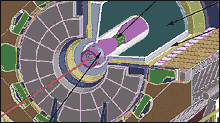




The STAR Detector
The Solenoidal Tracker at RHIC, known as STAR, tracks the thousands of particles produced by ion collisions at RHIC. STAR is used to search for signatures of the form of matter that RHIC was designed to create: the quark-gluon plasma.
The STAR detector specializes in tracking the thousands of particles produced by each ion collision at RHIC. Weighing 1,200 tons and as large as a house, STAR is a massive detector. It is used to search for signatures of the form of matter that RHIC was designed to create: the quark-gluon plasma (QGP).
Detecting and understanding the QGP allows us to understand better the universe in the moments after the Big Bang, where the symmetries (and lack of symmetries) of our surroundings were put into motion. Unlike other physics experiments where a theoretical idea can be tested directly by a single measurement, STAR must make use of a variety of simultaneous studies in order to draw strong conclusions about the QGP. This is due both to the complexity of the system formed in high-energy nuclear collisions and the unexplored landscape of the physics being studied.

End view of a collision of two 30-billion electron-volt gold beams in the STAR detector at the Relativistic Heavy Ion Collider.

A Quarter-Century of Surprises: Exploring the Quark-Gluon Plasma
Thursday, December 18, 2025

Rare Particle Pairs Point to Primordial Soup's Temperature at Different Stages
Thursday, November 13, 2025

More Signs of Phase-change 'Turbulence' in Nuclear Matter
Monday, September 29, 2025

2025 Annual RHIC & AGS Users' Meeting Celebrates Past and Looks to the Future
Thursday, June 26, 2025

STAR Data Reveal 'Splash' of the Quark-Gluon Plasma
Wednesday, June 11, 2025

Multiple Detectors
STAR consists of several types of detectors, each specializing in detecting certain types of particles or characterizing their motion. These detectors work together in an advanced data acquisition and subsequent physics analysis that allows final statements to be made about the collision.

The Heart of STAR
STAR's "heart" is the Time Projection Chamber which tracks and identifies particles emerging from heavy ion collisions. As each collision occurs, STAR measures many parameters simultaneously to look for signs of QGP.

'Reversing' Time
By using powerful computers to reconstruct the sub-atomic interactions which produce the particles emerging from each collision, the detector can, in a sense, run time backwards. This process can be compared to examining the final products which come out of a factory and trying to determine what kinds of machines produced them.

The STAR Collaboration
The STAR collaboration is composed of hundreds of scientists and engineers from the U.S. and abroad. STAR is composed of 55 institutions from 12 countries, with a total of 609 collaborators. A variety of personnel participate in the collaboration, including students, university faculty and staff, national laboratory staff, and engineers.
Funding Agencies

Office of Nuclear Physics of U.S. Department of Energy's Office of Science
U.S. National Science Foundation
Federal Ministry of Education and Research of Germany
National Institute of Nuclear Physics and Particle Physics of the National Center for Scientific Research of France
United Kingdom Engineering and Physical Sciences Research Council
National Research Foundation, the Ministry of Science, Education and Sports of the Republic of Croatia
Ministry of Education and Science of the Russian Federation
Research Supporting Foundation of the State of Sao Paulo, Brazil
Russian Ministry of Science and Technology
National Natural Science Foundation of China
Chinese Academy of Science, the Ministry of Science and Technology of China
Ministry of Education of China
Grant Agency of the Czech Republic
Department of Energy of India
Department of Science and Technology of India
German Bundesministerium fur Bildung, Wissenschaft, Forschung and Technologie (BMBF)
Council of Scientific and Industrial Research of the Government of India
Swiss National Science Foundation
Netherlands Foundation for Fundamental Research on Matter
Polish State Committee for Scientific Research
Science and Technology Assistance Agency of Slovakia
The Helmholtz Association
National Science Centre of Poland
National Research Foundation of Korea
RosAtom of Russia
